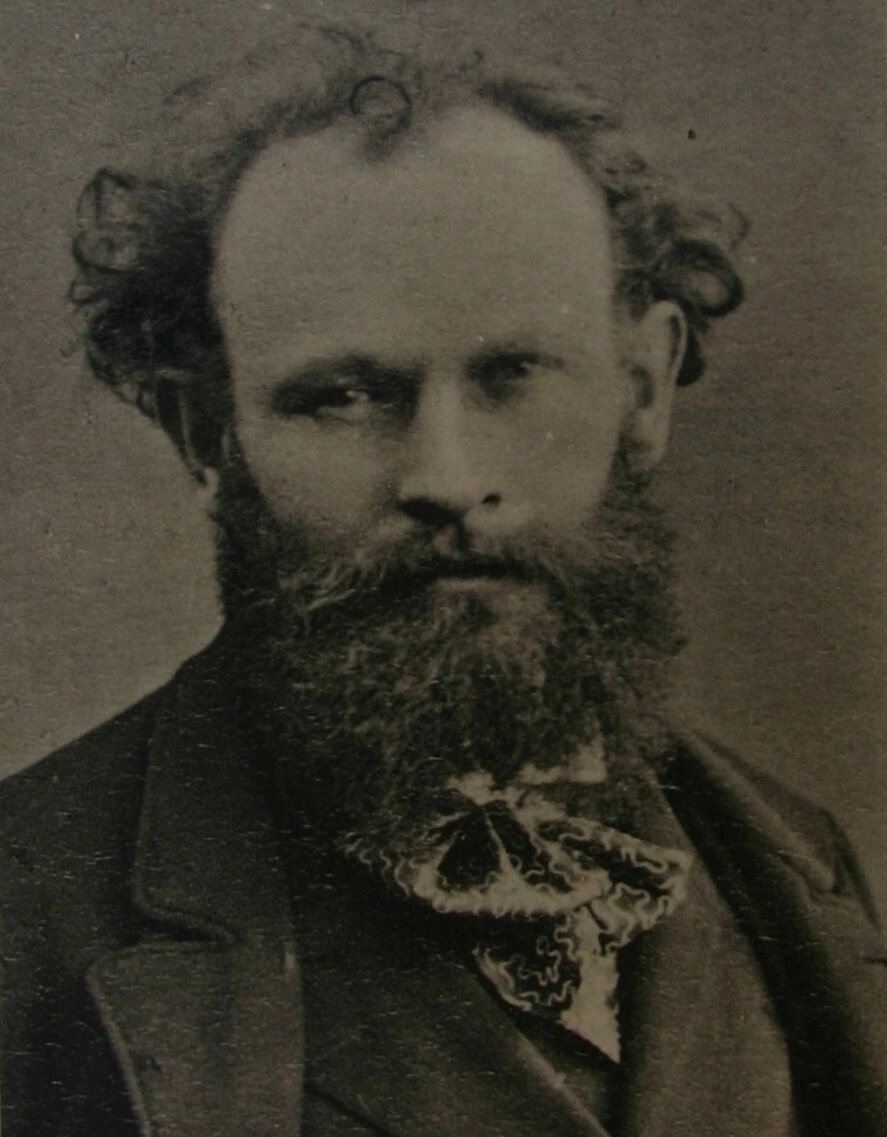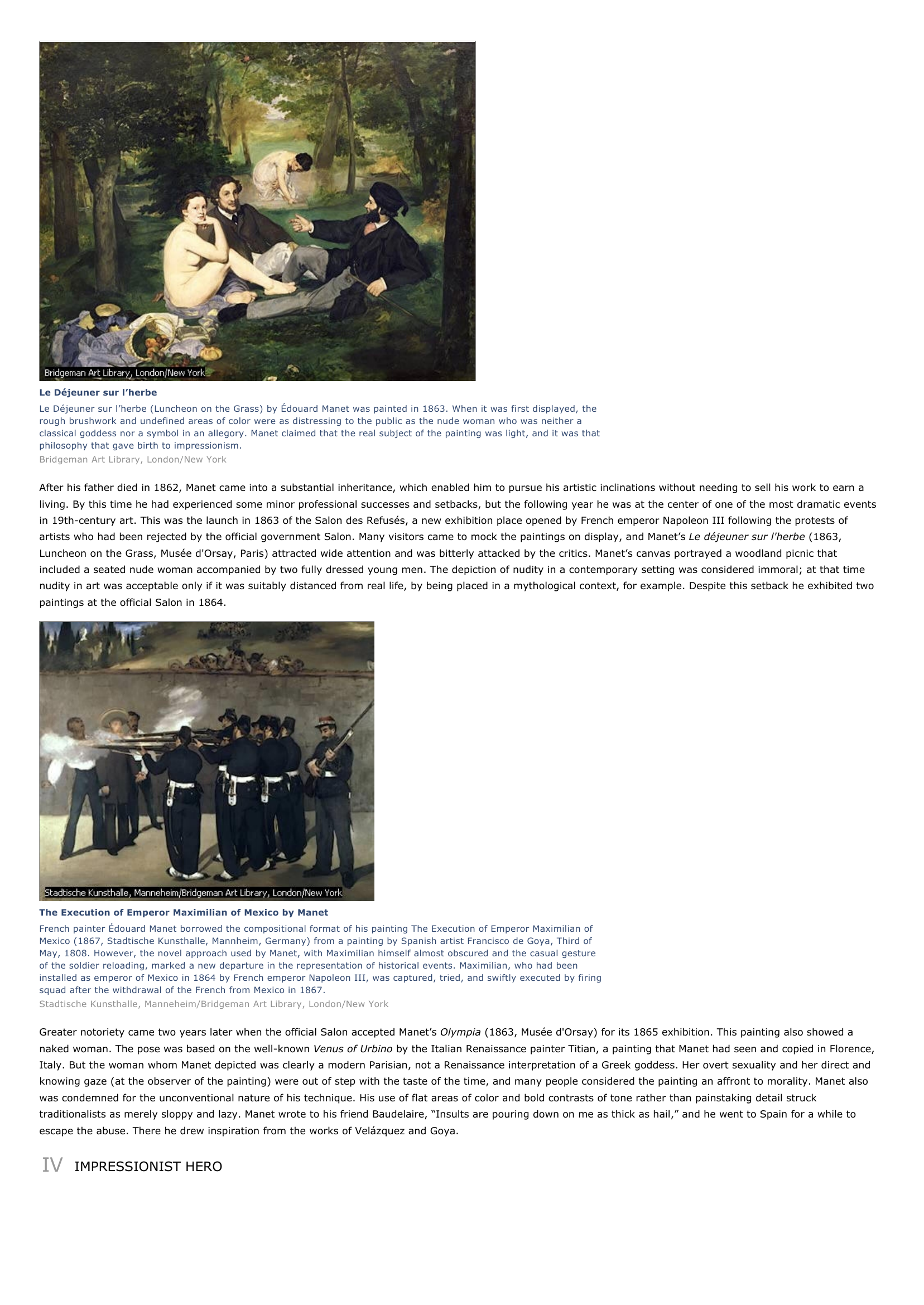Édouard Manet I INTRODUCTION Manet: Tradition and Innovation French impressionist painter Édouard Manet shocked art audiences in Paris with Le déjeuner sur l'herbe (The Luncheon on the Grass; 1863, Musée d'Orsay, Paris), which depicts a nude woman at a woodland picnic.
Publié le 12/05/2013

Extrait du document


«
Le Déjeuner sur l’herbeLe Déjeuner sur l’herbe (Luncheon on the Grass) by Édouard Manet was painted in 1863.
When it was first displayed, therough brushwork and undefined areas of color were as distressing to the public as the nude woman who was neither aclassical goddess nor a symbol in an allegory.
Manet claimed that the real subject of the painting was light, and it was thatphilosophy that gave birth to impressionism.Bridgeman Art Library, London/New York
After his father died in 1862, Manet came into a substantial inheritance, which enabled him to pursue his artistic inclinations without needing to sell his work to earn aliving.
By this time he had experienced some minor professional successes and setbacks, but the following year he was at the center of one of the most dramatic eventsin 19th-century art.
This was the launch in 1863 of the Salon des Refusés, a new exhibition place opened by French emperor Napoleon III following the protests ofartists who had been rejected by the official government Salon.
Many visitors came to mock the paintings on display, and Manet’s Le déjeuner sur l'herbe (1863, Luncheon on the Grass, Musée d'Orsay, Paris) attracted wide attention and was bitterly attacked by the critics.
Manet’s canvas portrayed a woodland picnic thatincluded a seated nude woman accompanied by two fully dressed young men.
The depiction of nudity in a contemporary setting was considered immoral; at that timenudity in art was acceptable only if it was suitably distanced from real life, by being placed in a mythological context, for example.
Despite this setback he exhibited twopaintings at the official Salon in 1864.
The Execution of Emperor Maximilian of Mexico by ManetFrench painter Édouard Manet borrowed the compositional format of his painting The Execution of Emperor Maximilian ofMexico (1867, Stadtische Kunsthalle, Mannheim, Germany) from a painting by Spanish artist Francisco de Goya, Third ofMay, 1808.
However, the novel approach used by Manet, with Maximilian himself almost obscured and the casual gestureof the soldier reloading, marked a new departure in the representation of historical events.
Maximilian, who had beeninstalled as emperor of Mexico in 1864 by French emperor Napoleon III, was captured, tried, and swiftly executed by firingsquad after the withdrawal of the French from Mexico in 1867.Stadtische Kunsthalle, Manneheim/Bridgeman Art Library, London/New York
Greater notoriety came two years later when the official Salon accepted Manet’s Olympia (1863, Musée d'Orsay) for its 1865 exhibition.
This painting also showed a naked woman.
The pose was based on the well-known Venus of Urbino by the Italian Renaissance painter Titian, a painting that Manet had seen and copied in Florence, Italy.
But the woman whom Manet depicted was clearly a modern Parisian, not a Renaissance interpretation of a Greek goddess.
Her overt sexuality and her direct andknowing gaze (at the observer of the painting) were out of step with the taste of the time, and many people considered the painting an affront to morality.
Manet alsowas condemned for the unconventional nature of his technique.
His use of flat areas of color and bold contrasts of tone rather than painstaking detail strucktraditionalists as merely sloppy and lazy.
Manet wrote to his friend Baudelaire, “Insults are pouring down on me as thick as hail,” and he went to Spain for a while toescape the abuse.
There he drew inspiration from the works of Velázquez and Goya.
IV IMPRESSIONIST HERO.
»
↓↓↓ APERÇU DU DOCUMENT ↓↓↓
Liens utiles
- Francisco José de Goya y LucientesIINTRODUCTIONFrancisco de GoyaOne of the great masters of Spanish art, painter and illustrator Francisco José de Goya y Lucientes produced works ofconsiderable beauty and power.
- Le Corbusier Le Corbusier, professional name of Charles Édouard Jeanneret (1887-1965), Swiss-French architect, painter, and writer, who had a major effect on the development of modern architecture.
- Gothic Art and Architecture I INTRODUCTION Notre Dame Cathedral, Paris Notre Dame Cathedral, in Paris, was begun in 1163 and completed for the most part in 1250.
- Islamic Art and Architecture I INTRODUCTION Córdoba Mosque Courtyard This mosque and courtyard with its repeated horseshoe arches was built between the 8th and 10th centuries in Córdoba, Spain.
- Radioactivity I INTRODUCTION Marie Curie Working with her husband, Pierre Curie, French physicist Marie Curie discovered the radioactive elements polonium and radium in 1898.










